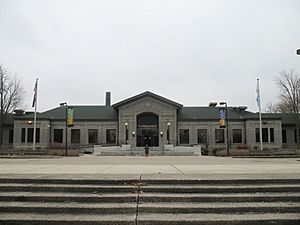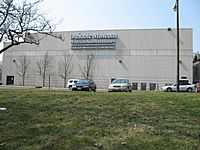DuSable Black History Museum facts for kids
 |
|
| Lua error in Module:Location_map at line 420: attempt to index field 'wikibase' (a nil value). | |
| Former name | Ebony Museum of Negro History and Art |
|---|---|
| Established | February 16, 1961 (current location since 1973) |
| Location | 740 East 56th Place Chicago, Illinois 60637 U.S. |
| Type | History museum, Art museum |
The DuSable Black History Museum and Education Center is a special place in Chicago. It used to be called the DuSable Museum of African American History. This museum helps us learn about and protect African-American history, culture, and art. It's named after Jean Baptiste Point du Sable, who was one of the first settlers in Chicago.
The museum was started in 1961 by Margaret Taylor-Burroughs, her husband Charles Burroughs, and other important people. They wanted to celebrate black culture. At that time, many museums and schools didn't focus on it. Today, the DuSable Museum is connected with the Smithsonian Institution. This means it works with a very famous group of museums.
Contents
History of the Museum
How the Museum Started
The DuSable Black History Museum officially opened on February 16, 1961. It began as the Ebony Museum of Negro History and Art. Margaret and Charles Burroughs, along with others, felt that black history and culture were missing from school lessons. They wanted to fix this.
The first museum was in the Burroughses' home at 3806 S. Michigan Avenue. In 1968, the museum was renamed after Jean Baptiste Point du Sable. He was a fur trader of African background. He was also the first non-Native-American person to settle permanently in Chicago.
During the 1960s, the museum and the South Side Community Art Center were very important. They created a special area for African-American culture. The original museum building was once a social club. It was also a place where African-American railroad workers could stay. This building is now a special Chicago Landmark. It is also listed on the National Register of Historic Places.
The DuSable Black History Museum quickly became very important. It offered cultural resources that were not easily found by African Americans in Chicago. It became a key place to learn about African-American history and culture. It also became a center for black social action in Chicago. The museum has hosted many events. These include political fundraisers and community festivals. The museum's idea has been copied in many other cities. These cities include Boston, Los Angeles, and Philadelphia.
Growing and Expanding
In 1973, the Chicago Park District gave the museum a building. This building was in Washington Park. It became the museum's new home. This building used to be a place where the Chicago Police Department held people.
In 1993, the museum grew even more. A new part was added. It was named after Mayor Harold Washington. He was the first African-American mayor of Chicago. In 2004, the original building became part of a special historic area. This area is called the Washington Park United States Registered Historic District.
The DuSable Black History Museum is the oldest museum of its kind. Before 2016, it was also the largest place in the United States that cared for African-American culture. It has grown over time to show the increased interest in black culture. This ability to change has helped it survive. Other museums have struggled when the economy was weak. In 2016, the museum officially joined with the Smithsonian Institution.
Antoinette Wright, a past director of the museum, has spoken about African-American art. She said that this art helped preserve history. This was important because it was hard to write things down in the past. She also believes the museum helps inspire people. It helps people from a culture that has faced many challenges.
Museum Collection

The new part of the museum has a special exhibit about Harold Washington. It shows things he owned and highlights his political career. The museum also honors du Sable, the founder of Chicago. Some important items in its collection include the desk of activist Ida B. Wells. It also has the violin of poet Paul Laurence Dunbar.
The museum has about 13,000 items. These include artifacts, books, photos, art, and other special things. Most of the DuSable collection came from private gifts. It has items from the time of slavery in the United States. There are also items from the 1800s and 1900s. It has old papers, like the diaries of sea explorer Captain Harry Dean.
The DuSable collection also includes works from famous people. These include scholar W. E. B. Du Bois, sociologist St. Clair Drake, and poet Langston Hughes. The African-American art collection has works from students of the South Side Community Art Center. These artists include Charles White, Richard Hunt, Archibald Motley, Jr., Gus Nall, Charles Sebree, and Marion Perkins. The museum also has many works from the New Deal period and the 1960s Black Arts Movement. It owns prints and drawings by Henry O. Tanner, Richmond Barthé, and Romare Bearden. There is also a large collection of books and records. These are about African and African-American history and culture.
Museum Facilities
The main entrance of the museum is on the north side. It has beautiful mosaics by Thomas Miller. These mosaics honor the people who started the museum. The building was designed around 1915. It was meant to be the South Park Administration Building in Washington Park. This park is on Chicago's South Side.
The new part of the museum is about 25,000 square feet. The museum has a large auditorium with 466 seats. This auditorium is part of the new wing. It hosts many community events. These include jazz and blues music shows, poetry readings, and film screenings. The museum also has a gift shop and a research library. The museum gets some of its money from a tax in the Chicago Park District.
After the new wing was added in 1993, the museum had 50,000 square feet of exhibit space. This expansion cost $4 million. Half of the money came from city and state officials. The museum has also been working to save and expand other buildings nearby. One of these is a special roundhouse building.
Key People
- Carol Moseley Braun, Board Chair (April 2025 - )
- Perri L. Irmer, President and CEO (September 2015 - )
See also
 In Spanish: DuSable Museum of African American History para niños
In Spanish: DuSable Museum of African American History para niños
- Barzillai Lew – Lew Family
- List of museums focused on African Americans
- List of museums and cultural institutions in Chicago
- Funky Turns 40: Black Character Revolution

